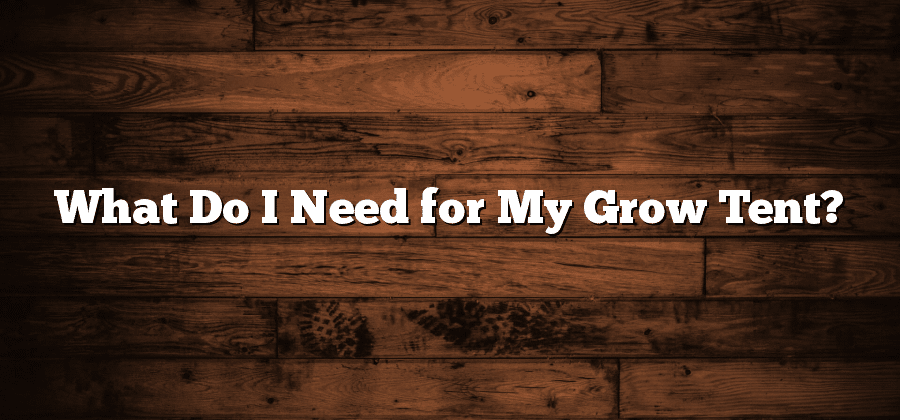Choosing the Right Size Grow Tent
When it comes to setting up a successful indoor garden, selecting the right size grow tent is of utmost importance. A grow tent provides a controlled environment for your plants, protecting them from external factors and facilitating optimal growth. Before diving into the realm of indoor gardening, it is crucial to carefully consider the size of the grow tent that best suits your needs.
One of the key factors to consider when choosing the right size grow tent is the space available in your home or dedicated growing area. Measure the dimensions of the space you have allocated for your indoor garden, ensuring that there is sufficient room for the grow tent, as well as space to move around and work comfortably. Remember to also take into account any additional equipment, such as exhaust fans or grow lights, that might require extra space. By carefully assessing your available space, you can determine the appropriate size of grow tent that will fit seamlessly into your indoor gardening setup.
Essential Lighting Equipment for Grow Tents
Grow tents provide an ideal environment for indoor gardening, allowing you to control various factors like temperature, humidity, and lighting. When it comes to lighting, choosing the right equipment is crucial for the success of your plants. Adequate lighting ensures that your plants receive the necessary amount of light energy for photosynthesis, which is essential for their growth and development.
There are a few options for lighting in grow tents, with the most commonly used being fluorescent lights, LED lights, and high-intensity discharge (HID) lights. Fluorescent lights are cost-effective and emit a relatively low amount of heat. LED lights, on the other hand, offer energy efficiency and customizable light spectrums to suit different stages of plant growth. HID lights, such as metal halide (MH) and high-pressure sodium (HPS) lights, are known for their intense brightness and are effective at promoting flowering and fruiting. Depending on your budget and the specific requirements of your plants, you can choose the lighting option that best fits your needs.
Ventilation and Airflow in Grow Tents
Proper ventilation and airflow are crucial factors to consider when setting up a grow tent. Adequate airflow helps to maintain a healthy environment for your plants and ensures optimal growth and development. Without proper ventilation, stagnant air can lead to issues such as mold, mildew, and pest infestations.
To ensure good airflow in your grow tent, it is recommended to have both an intake and exhaust fan. The intake fan brings fresh air into the tent, while the exhaust fan removes stale air and heat. It is important to choose fans that are suitable for the size of your grow tent to ensure proper air circulation. Additionally, using ducting and carbon filters can help to effectively remove odors and pollutants from the tent.
Another important aspect of ventilation is managing humidity levels. High humidity can lead to the growth of mold and mildew, which can be detrimental to your plants. A dehumidifier can help to control humidity levels and prevent these issues. Additionally, it is essential to regularly monitor and adjust the fan speed and airflow to ensure the appropriate levels for your plants’ needs.
In conclusion, proper ventilation and airflow are crucial for the success of your grow tent. By ensuring good air circulation, managing humidity levels, and investing in the right fans and equipment, you can create a healthy and optimal growing environment for your plants. Remember to regularly maintain and monitor the ventilation system to ensure its efficiency and effectiveness.
Selecting the Proper Growing Medium
One of the most critical decisions for indoor gardeners is selecting the proper growing medium. The growing medium, also known as the growing substrate, serves as the home for your plants’ roots and provides a structure for water and nutrient absorption. With various options available, choosing the best growing medium for your grow tent can greatly impact the growth and overall health of your plants.
When selecting a growing medium, it is essential to consider its water-holding capacity, aeration, and drainage properties. Soilless mixtures, such as coco coir or peat moss, are popular choices as they provide excellent moisture retention while allowing for proper drainage. These substrates are also lightweight, making it easier to manage and transport. Additionally, using soilless mixtures reduces the risk of pests and diseases, creating a cleaner and more sterile environment for your plants. Ultimately, selecting the proper growing medium will play a crucial role in providing the necessary support, moisture, and nutrients for successful plant growth in your grow tent.
Understanding Nutrients and Fertilizers for Grow Tents
When it comes to growing plants in a grow tent, understanding the role of nutrients and fertilizers is crucial for achieving successful yields. Nutrients are essential elements that plants need to grow, such as nitrogen, phosphorus, and potassium. These nutrients are typically found in soil, but in a grow tent, where plants rely on a growing medium like soilless mix or hydroponics, they need to be provided by the grower.
Fertilizers, on the other hand, are additives that contain specific concentrations of these essential nutrients. They are used to supplement the nutrient requirements of plants and ensure they receive the proper balance of elements for healthy growth. Fertilizers can come in various forms, including liquid, granular, or slow-release pellets. Each type has its advantages and specific application methods, allowing growers to tailor their nutrient regimen according to the needs of their plants. Additionally, understanding the nutrient requirements of different plant stages, such as vegetative growth or flowering, is vital for selecting the appropriate fertilizers and achieving optimal results.






